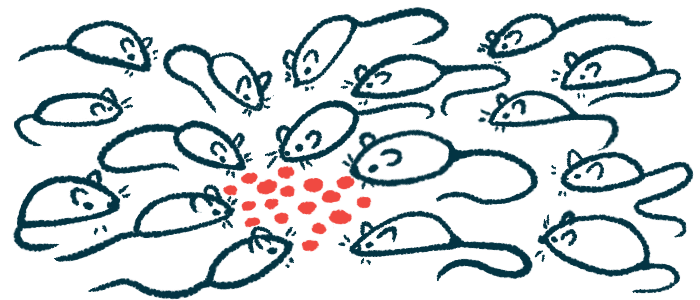Molecule Shows Potential to Treat PF in Surprising Manner
Mouse study finds TH5487 blocks activity and levels of enzyme tied to scarring

The small molecule TH5487 safely and effectively treated pulmonary fibrosis (PF) in a mouse model, a study reported.
Although TH5487 is known to block the activity of the DNA repair enzyme OGG1, its anti-fibrotic effects occurred, in part, by reducing the production of OGG1 itself. According to researchers, these findings support the development of TH5487 as a promising PF treatment.
The study, “TH5487, a small molecule inhibitor of OGG1, attenuates pulmonary fibrosis by NEDD4L-mediated OGG1 degradation,” was published in the journal Chemico-Biological Interactions.
The progressive scarring of lung tissue that marks PF is driven by a pro-fibrotic signaling protein called TGF-beta1. After binding to its receptor, TGF-beta1 triggers a series of processes leading up to scar tissue formation. Smad7 is a protein that prevents TGF-beta1 from binding to its receptor, thus acting as a regulator to restrain the scarring process.
OGG1, an enzyme, is known to participate in DNA repair by removing damaged building blocks from the DNA chain. Recently, researchers at the Affiliated Hospital of Guangdong Medical University in China showed that OGG1 also suppresses the action of Smad7, facilitating PF development induced by TGF-beta1.
TH5487 is a small molecule inhibitor of OGG1, suggesting it may have anti-fibrotic properties. To find out, the team tested TH5487 in mice that were exposed to bleomycin, a toxic chemical that causes scar tissue to form in the lungs, mimicking that seen in PF patients.
Little scarring evident in lung tissues of mice given TH5487
Mice were treated with TH5487, as well as the approved anti-fibrotic IPF therapy pirfenidone (sold as Esbriet) as a positive control. Both were administered by abdominal injection. These mice showed little scar formation in lung tissues and markedly lower levels of proteins involved in scarring.
At the highest TH5487 dose, there was no significant toxicity and no signs of organ damage, changes in blood markers, or other parameters, “showing a good safety profile of this candidate agent as a potential treatment for pulmonary fibrosis,” the researchers wrote.
In PF, the epithelial cells that line the alveoli — the tiny air sacs in the lungs where gas exchange takes place — transition to mesenchymal cells, a cell type that generates proteins involved in scarring through a process known as epithelial-mesenchymal transition (EMT). Both TH5487 and pirfenidone significantly attenuated EMT.
Researchers then examined mice genetically engineered to lack OGG1. These mice showed reduced lung fibrosis, EMT, and fibrosis-related proteins after bleomycin exposure compared with normal mice. However, TH5487 treatment did not further mitigate bleomycin-induced fibrosis or EMT in the lungs of OGG1-deficient mice.
“Collectively, these results indicate that OGG1 has a pivotal role in the TH5487-mediated regression of pulmonary fibrosis,” the team wrote.
Protein analysis found elevated expression, or production, of OGG1 in the lungs of bleomycin-injured mice relative to control mice. TH5487 treatment significantly reduced bleomycin-induced OGG1 expression at the protein level, which was an interesting finding, since “TH5487 is best known as an OGG1 activity inhibitor that prevents OGG1 from interacting with its DNA substrate.”
To investigate this further, researchers modified mice to overexpress OGG1 specifically in the lungs. After bleomycin exposure to induce fibrosis, modified mice developed more severe lung damage, enhanced EMT, and had increased levels of fibrosis-related proteins than nonmodified mice with induced fibrosis. Notably, TH548 was no longer effective in treating lung fibrosis when OGG1 was overexpressed.
“Overall, the above results support the therapeutic effect of TH5487 on [bleomycin]-induced pulmonary fibrosis in mice, at least in part through its inhibitory effect on OGG1 expression rather than its role in OGG1 activity repression,” the scientists wrote.
Consistent with these mouse findings, OGG1 protein expression was elevated by TGF-beta1 in alveoli epithelial cells (AECs), while TH5487 treatment blocked this increase, but not by affecting the activity of the gene that encodes OGG1.
Instead, scientists found that TH5487 prevented TGF-beta1-induced suppression of NEDD4L, a protein that normally tags OGG1 for degradation. This means that TH5487 lowered OGG1 levels, and thereby treated PF, by promoting the enzyme’s breakdown.
“These data suggest that OGG1 … degradation due to NEDD4L induction could be necessary for TH5487 to exert its anti-fibrotic effect,” the researchers wrote.
“We propose that TH5487 exhibits anti-fibrotic activity in the lung, which is partially mediated by reducing the expression of OGG1 protein, and not solely by inhibiting OGG1 activity,” they added. “The present findings collectively support the development of TH5487 as a promising reagent for the treatment of pulmonary fibrosis.”








